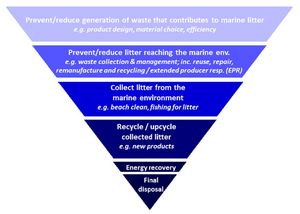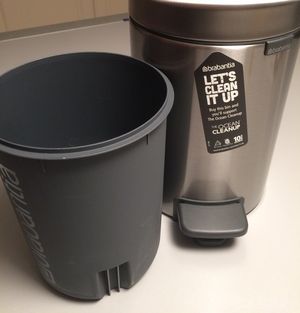Marine litter – Plastic in the oceans
Marine litter – Plastic in the oceans
| Author: Patrick Semadeni
Who hasn't seen the pictures of plastic waste on the beaches and in the water. Known as marine litter, politics and industry are addressing this problem. We processors have also our share of responsibility, and can make a contribution to improve the situation.
Plastics end up in the oceans
Every year, between 5 and 12.5 million tonnes of plastic from coastal regions end up in the oceans. A further 0.075-1.1 mil. tonnes come from non-coastal areas or from ships1. This ranges from very small particles (nano particles from cosmetics, fibres from textiles and fleeces) to medium sized objects such as lids and bottles, right up to bigger parts such as tyres or cool boxes. Currently the quantity of plastics in the oceans is estimated at 150 mil. tonnes2. The majority of plastics in the oceans come from South East Asia, with China and the Philippines at the top of the list3.
This plastic in the oceans is problematic in various regards:
- Threat to the wildlife due to consumption of plastics
- Pollution of water and beach
- Wasting plastic raw materials
What solution approaches are there?
How can the problem of marine litter be tackled? The IEEP1 suggests the following pyramid of measures:
(please click to enlarge)
The industry can initially act on the first stage. Currently, various initiatives are in progress, to make the design of plastic parts, especially packaging, recycling friendly. We will talk about these initiatives known as "Design for Recycling" in a separate blog article.
The second stage - the lack of infrastructure for waste management - is located at the level of politics and development assistance.
The initiative Waste Free Oceans
However, if plastic has already gotten into the oceans, then it is necessary to remove it again, as plastic only breaks down very slowly. For this purpose, the EuPC - European Association of Plastic Converters - has entered into a strategic partnership with the organisation Waste Free Oceans WFO. The association Swiss Plastics is also a member of the EuPC.
The WFO makes the claim "we collect and upcycle ocean plastic". In cooperation with fishermen worldwide, fishing nets are collected and recycled. Products can then be manufactured from the raw material gained, in the sense of a circular economy.
Since 2011, the WFO has carried out ocean clean-ups in many countries: Belgium, France, Denmark, Portugal, Turkey and Brazil. The WFO has currently entered into a partnership with the WWF (World Wildlife Fund) Hong Kong. Part of this partnership will also be a clean-up event in the Hong Kong Bay. Therefore the WFO is already active on three continents4.
Yet plastic waste is also collected on the beaches. The organisation TerraCycle works with volunteers from all over the world, and offers free recycling programmes. Almost 64 million people are involved in these programmes5.
This summer, the first product worldwide that containes 25% recycling plastic collected by TerraCycle on the beaches will come onto the global market: a shampoo bottle by "Head and Shoulders" (Procter & Gamble), which will be sold in France by the Carrefour retailer6!
In Switzerland supporting measures were already introduced in various purchase houses to release the oceans from the tonnes of garbage. With every sold product, as for example the rubbish bin of Brabantia, a contribution is paid to "The Ocean Cleanup".
The "Declaration of the Global Plastics Associations for Solutions on Marine Litter"
69 associations from 35 countries - as well as the European Association of plastic manufacturers, Plastics Europe - committed to supporting various measures against marine litter in a joint declaration in 2011. This includes topics such as raising public awareness of the problem in the affected countries, informing, providing facts, supporting collection projects. Also the "Zero Pellet Loss" initiative is remarkable: this aims to not allow any pellets that occur during production into the surrounding area across the whole added value chain which could end up in the water7.
So, a number of significant initiatives originated by or supported by industry associations are underway towards getting the problem of marine litter under control. But there is still a great deal to do. We as processors can take responsibility by:
- advocating WFO projects in the associations.
- driving forward the use of Post Consumer Recycling (PCR) plastics, and therefore also use PCR plastics collected on the beach.
- ensuring in our own operations that no plastics end up in the water.
However, everyone in the chain is needed: Responsible raw material manufacturers and processors, brand owners who fill their products in PCR plastic packages, consumers who are not bothered by the fact that a PCR package does not come out quite as lily white, buy the products and then dispose of the packaging correctly after use and/or feed it into the collection systems.
1 IEEP Institute for European Environment Policy, Plastics, Marine Litter and the Circular Economy, October 2016
2 Marine Litter, European Commission, Good Environmental Status, April 2017
3 Here's where the Ocean's trash comes from, National Geographic Magazine, April 2017
4 www.wastefreeoceans.org/fishingoceanplastic
5 www.terracycle.de
6 Press release, P&G's Head & Shoulders Creates World's First Recyclable Shampoo Bottle Made with Beach Plastic, 19. Januar 2017
7 Marine Litter Solutions, Declaration of the Global Plastics Associations for Solutions on Marine Litter, 2011



